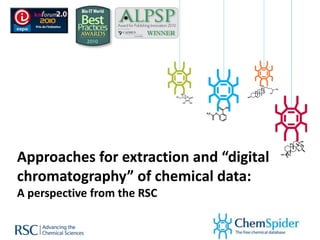
Digital extraction of chemical data
- 1. Approaches for extraction and “digital chromatography” of chemical data: A perspective from the RSC
- 2. Overview • Introduction – What data can we consider? – What are the challenges – What data and sources does the RSC have? – Experimental Data Checker • Case Studies: – Project Prospect – Chair forms of Sugars/cyclohexanes
- 3. Traditional Chromatography Images taken from: http://www.sciencemadness.org/talk /viewthread.php?tid=3960&page=3 http://en.wikipedia.org/wiki/Column_ chromatography
- 4. Why Digital Chromatography? • Useable information is mixed in with description and analysis – Makes it difficult to find • Despite our best efforts – still lots of ambiguous or plain wrong/unusable chemical information • Why? – Human error – Processing errors – Incorrect usage of data generation/extraction – Style over meaning – Data not generated with reuse in mind – Data generated for humans
- 5. Style/Layout Vs Meaning • Structures drawn to illustrate more than just the identity • Data not generated with reuse in mind • Author practices • Mixed 2D and perspective representations • Unintentional definition of stereochemistry
- 6. Data generated for humans • Separated/Orphaned information inc. Markush structures, information passed by reference
- 8. What chemical data can we consider? • Chemistry is an especially challenging - wide range of types of data – Numeric data – Names – Structures – Terminology • Over a hugely different set of topics: Org, Inorg, Physical – Meanings/interpretations are not perfectly aligned • Application of standards can be challenging • Drawing conventions – are documented but not used
- 9. What chemical data and sources does the RSC have?
- 10. A beginning: helping chemists review their own work Amphidinoketide I To a solution of……. …. Amphidinoketide I was isolated as a …….. [α]D25 −17.6 (c 0.085, CH2Cl2); Rf = 0.61 (1:1 hexane:ethyl acetate); νmax(CHCl3)/cm−1 1707.2 (CO), 1686.9 (CO), 1632.4 (CO), 1618.9 (CC), 1458.1; 1H NMR (CD2Cl2, 500 MHz) δH 6.08 (1H, t, J = 1.3 Hz, 3-CHC), 5.82 (1H, ddt, J = 16.9, 10.2, 6.7 Hz, 19-CHCH2), 4.99 (1H, m (17.1 Hz), 20-CHA), 4.92 (1H, m (10.2 Hz), 20-CHB), 3.05 (1H, dd, J = 17.9, 9.3 Hz, 8-CHA), 3.00–2.90 (3H, m, 9-CHCH3, 11-CHA, 12-CHCH3), 2.72–2.64 (2H, m, 5-CHA, 6-CHA), 2.62–2.55 (2H, m, 5-CHB, 6-CHB), 2.51–2.45 (3H, m, 8-CHB, 11-CHB, 14-CHA), 2.33 (1H, dd, J = 16.9, 7.4 Hz, 14-CHB), 2.09 (3H, s, 21-CH3), 2.05–1.99 (2H, m, 18-CH2), 1.99–1.96 (1H, m, 15-CHCH3), 1.88 (3H, s, 1-CH3), 1.39–1.25 (3H, 17-CH2, 16-CHA), 1.14–1.10 (1H, m, 16-CHB), 1.07 (3H, d, J = 7.0 Hz, 22-CH3), 1.05 (3H, d, J = 7.2 Hz, 23-CH3), 0.87 (3H, d, J = 6.7 Hz, 24-CH3); 13C NMR (CD2Cl2, 125 MHz) δC 213.15 (13-CO), 212.08 (10-CO), 208.40 (7-CO), 198.76 (4- CO), 155.40 (2-CCH), 138.41 (19-CHCH2), 123.54 (3-CHC), 114.19 (20-CH2C), 48.81 (14-CH2), 45.93 (11-CH2), 44.50 (8-CH2), 41.43 (9-CHCH3), 41.01 (12-CHCH3), 37.74 (5-CH2), 36.55 (16-CH2), 36.27 (6- CH2), 34.18 (18-CH2), 28.74 (15-CHCH3), 27.57 (1-CH3), 26.60 (17-CH2), 20.63 (21-CH3), 19.77 (24- CH3), 16.65 (22 or 23-CH3), 16.62 (22 or 23-CH3); HRMS (ESI) Calculated for C24H38O4 413.2668, found 413.26600 (MNa+). (9R, 12R, 15S)-1 had [α]D25 +11 (c 0.245, CH2Cl2). • http://www.rsc.org/is/journals/checker/run.htm
- 11. Case study 1: Project Prospect
- 12. What is Prospect? Visible output Enhanced Prospect InChI–name pairs Better Output layer RSS HTML database (in ChemSpider) ontologies Information layer Enhanced RSC XML Tool layer OSCAR InChI–Name pairs Author Input layer Ontologies RSC XML (from ChemSpider) CDX files 12
- 13. People and machines People Machines Can understand narratives. Can’t understand narratives. Can interpret pictures. Can’t interpret pictures. Can reason about three- Not able to infer 3D structure dimensional objects. from 2D without cues. Can do a high-quality job. Can do a lower-quality, but still useful job.
- 14. Case study 2: The chair representation issue InChI=1S/C6H12O6/c7-1-2-3(8)4(9)5(10)6(11)12-2/h2-11H,1H2 WQZGKKKJIJFFOK-UHFFFAOYSA-N • 5 stereocentres = 2^5 isomers =32 structures
- 15. Case study 2: Chair forms of hexacycles what could go wrong?
- 16. How do we “fix” chair-representations How we normalize them: 1. Identify 6-membered rings (Indigo) 2. Identify what sort of ring it is 3. Map atoms onto a standard structure (eg. beta-D-glucopyranose) 4. Tidy
- 17. The future: “The digester” • Ability to: – Reconnect R-groups – Expand abbreviations – Expand brackets – Link structures with reference IDs
- 18. Other examples that we didn’t mention in case studies • CIF data importer • Structure Validation and Standardisation – (Thurs Aug 23, 9:15 am, Marriott Downtown, Franklin Hall 6) • Work on creation of ontologies, RXNO, CMO – Also collaborating on: ChEBI ontology, GO, SO • Collaboration with Utopia to enable Prospect mark-up of PDFs
- 19. Summary • Many data sharing practices are based on: – Traditional print articles – Consumption of data by humans only • This poses issues for publishers and users alike • The RSC is developing innovative solutions to address some of these problems – Chemical structures are challenging – Limitations to what a machine methods can achieve – Need to educate authors to think differently
- 20. Acknowledgements • Colin Batchelor - Development and Technical work • Jeff White & Aileen Day • Richard Kidd, Graham McCann and Will Russell • RSC ICT staff
- 21. Thank you Email: chemspider@rsc.org Twitter: @ChemSpider http://www.chemspider.com
